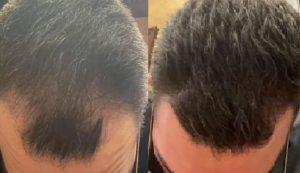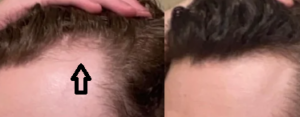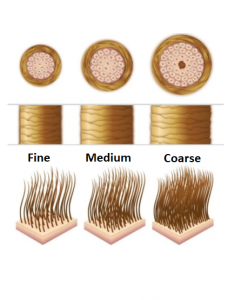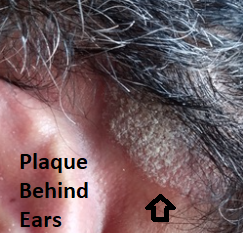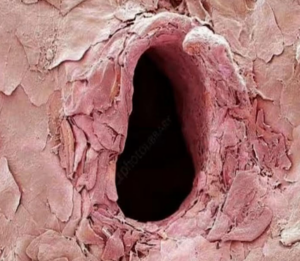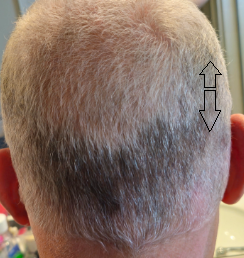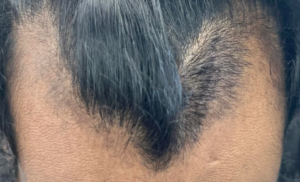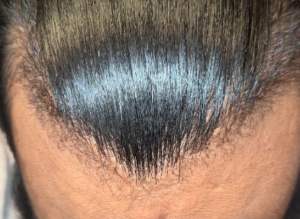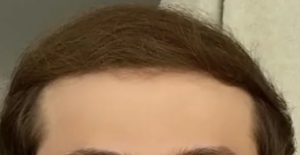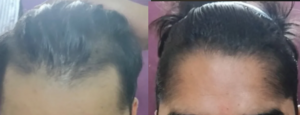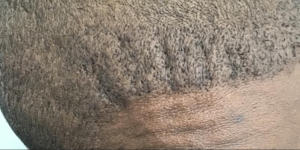This 26-year-old male has reversed his corner recession around what appears to be a persistent forelock with a combination of 1mg Fin oral every day, 5% minoxidil topical once a day, and microneedling 1.5mm once a week for 1 1/2 years. Many doctors would have transplanted this man; however, the issue may be one of continued treatment and how long the treatment will hold up. With the transplant alternative, I can state that once it is done, it is done (without maintenance other than possible finasteride to avoid the further progression of the balding pattern).
When estimating the number of grafts a person needs, I always want to know the hair thickness (hair bulk) of the donor area. Hair bulk is not hair or graft density. I initially saw the graphic at the bottom of this post on Reddit.com. For a visual representation, the graphic artist kept the number of hairs the same and changed the thickness of the hair shafts to show the value of hair thickness in producing coverage. Dr. Sharon Keene nicely demonstrated this with real hairs and got the same result as the graphic demo below. So you see, if your hair is fine, it will take a lot more hair to get the fullness of a person with medium-weight or coarse hair. This is why people with fine hair often get a second hair transplant. Fine hair is clearly better than no hair, but when a person with fine hair gets a hair transplant, they should accept that they will never have the look of Brad Pitt’s hair, while a person with thicker hair shafts, a Brad Pitt expectation may be realistic. The chart below shows the value of thicker hair shafts very nicely.
Let’s drill down on an example: Look at the chart below; let’s suppose that a balding man has medium hair (50microns thick). His friend had a hair transplant and had fine hair in his donor area, with a hair thickness of 30 microns. His friend had a hair transplant, and it doesn’t look like he has a full head of hair after the transplant despite getting 4000 grafts. He is concerned that he might not be happy with the type of results his friend had. If he does the analysis, he will find that he has 7.1 times the hair bulk as his friend with fine hair whose donor hair thickness had 30-micron hair shafts (50/0.7 = 7.1). I would tell him that if I were his surgeon, he would get much fuller-looking results than his friend, not because I am a better surgeon than his friend’s surgeon but because his hair thickness will produce more hair bulk than his friend’s fine hair gave him. The amount of hair bulk is a simple math calculation reflecting the area of a circle [ Pie (r)² ]. If you want to run the calculations, you will know the value of your hair thickness, and everyone having a hair transplant should do this to establish realistic expectations.
In my 35 years performing hair transplants, I have transplanted many men with fine hair. They were generally pleased because they got back the hair they always had, which was fine hair. A fine-haired man getting a hair transplant for balding doesn’t have the expectation that his hair would look like Antonio Banderas’s hair because they never had it.
In the late 1980’s. Dr. Manny Marritt had a light-skinned Caucasian human volunteer with black, medium-weight hair (~50-micron hair thickness) agree to have half the hairs on one side of his head plucked out. Then, Dr. Marritt brought in independent observers and photographers to see if the lower-density side could be detected. The answer was NO! That told me that in the worst situation possible (black, medium-weight hair on white skin), 50% density produced the same fullness as 100% density. With that being the case, a person with medium-weight hair that is blonde with a blondish skin color or a brown-haired, brown-skin colored man would require less than 50% of their original density to get a full look from a hair transplant. I have found that to be true, and that is the art of what a good hair transplant surgeon offers. When the hair transplant surgeon combines this knowledge with proper hair distribution, the best results are produced with the least amount of hair and cost to the patient.
For those readers who want to know where they stand about hair thickness, to get some realistic expectations for a hair transplant, you can purchase a micrometer for under $25 on Amazon, cut 10 of your donor area (back of your head), and measure the thickness by averaging their width of those 10 hairs. Use the chart below to understand the measurement and consider Dr. Marritt’s simple experiment. The micrometer can be purchased here: https://www.amazon.com/dp/B09964YBMF?ref=ppx_yo2ov_dt_b_product_details&th=1
The illustrations below show the same number of hairs, but the hairs are thicker. Please note the HUGE visual difference between fine, medium, and coarse hairs regarding the fullness each group produces.
You can contact me at williamrassman33@gmail.com
https://pmc.ncbi.nlm.nih.gov/articles/PMC8122395/
I had a hair-shedding problem my entire life. As I got older, it became progressively worse. I came across the following study a couple years ago. After a lot of experimentation, the best application of microcurrent to the scalp that halted nearly all of my hair shedding was the following:
-1 milliamp current
-Bipolar Waveform
-10 to 100 Hertz
Factors that can play a role in the efficacy of this treatment include:
-Scalp Thickness
-Microcurrent Device Manufacturer
-Frequency of Treatment
-Duration of Treatment Session
I’ve been doing this treatment for about 18 months. This treatment is relatively safe and inexpensive. I thought it might interest your readers on baldingblog.com.
This shows a needle puncture in the skin that is clearly present, after the needle exits the skin. For those people who get Scalp Micropigmentation, this is also present, just in the thousands. The hole usually fills in quickly from below, but when doing SMP, I always ask the patient not to shampoo or use alcohol in any manner for 3 days after getting SMP. If this rule is not followed, then the detergent will go through some of the holes and cause the tattoo ink to dissipate, making what was a “DOT” into a “Blob”
It’s been 5 months since I’m applying topical minoxidil, now planning to switch to oral as it’s much more simpler to pop a pill, What all things should I consider before switching to oral and hope it’s safe to take oral and there are enough studies for same.
The oral is fairly safe, provided that your dose does not exceed 2.5mgs. Look up the side effects on Google, well defined. The worst of the side effects are cardiac, so make sure that if you get swelling of your feet and legs, that you speak with your doctors and probably stop the oral minoxidil.
Sometimes it is unfair that some people get a great hairline regarding genetics. I believe Stalin might never have succeeded as a dictator had he been bald! A full head of hair gives great confidence to those with it. Look at Bill Clinton’s hairline as such an example? Men’s Fitness did an article some years ago reviewing the political ramifications of not having hair. Since Eisenhower, there has not been a bald president in the United States. Donald Trump knew this and tied a perception of good hair with a lace hair system (a wig) to build his personal confidence. The public doesn’t know Donald Trump is bald because they know him as a hairy man with a strange hairstyle.
Response from Reddit poster: I had this happen to me firsthand from 16 until 24. I ran a community in the mountains of Ohio, and year after year, we were gaining more and more followers. I could Stockholm syndrome a beatiuful model, even a wealthy businessman in no less than 3 hours. Then baldness struck, no new members, all my wives left me for one of my enforcers who had beatiuful luscious hair, but I guess the hair loss saved my ass the feds raided the community like a year later. I’ve been saving up for a $30,000 for graft treatment, so maybe one day I can create another community
Just be careful because as you get older, if the balding gets worse, you will have to address your problem with less hair, and eventually, everyone will detect it. There are many solutions today for young men, including medications, microneedling, and hair transplants for men over 26. All of these modalities can help you grow your own hair, even hidden by your present hairstyle, so that one day, you will unveil a new look that is far more natural than where you might be heading. You can get my help with a free consultation at williamrassman33@gmail.com
If I was to get SMP, would it be pointless staying on meds to keep/grow my hair?
SMP colors your scalp with small tattooed dots, barely the size of a dot from a ballpoint pen, but hair growth is independent. If you stop taking medications like finasteride or oral minoxidil, you will lose all the benefits of the drugs you accumulated over time. Think this through. Do you want the SMP to be your presentation to the world with a shaved head? To do this with SMP alone, your SMP must be meticulously done. I have seen a lot of good SMP with a shaved scalp, which is a reasonable option if it is done well; however, so many of today’s SMP providers just don’t do great work. Be sure to ask to meet some of the SMP patients who shave their heads before going forward with any provider.
ABSTRACT
Clostridium difficile infections can be life-threatening but are increasingly being treated successfully with fecal microbiota transplantation (FMT). We report two patients with alopecia universalis who developed subsequent hair regrowth after FMT for treatment of recurrent C. difficile infections. Gut microbiota may have immunomodulatory effects in autoimmune conditions such as alopecia areata, and further study may elucidate disease mechanisms and lead to alternative treatment options for these patients for whom treatment options are currently limited.
Comment: Alopecia Totalis Wikipedia states: “Alopecia totalis is the loss of all hair on the head and face. Its causes are unclear but believed to be autoimmune. Research suggests there may be a genetic component linked to developing alopecia totalis; the presence of DRB1*0401 and DQB1*0301, both of which are human leukocyte antigens (HLA), were found to be associated with long-standing alopecia totalis.”[1]
We know so little about how our GUT controls us, our immunity, our health, and possibly how long we may live. Imagine that this woman, with no hair on her body for maybe years, with failures in all sorts of treatments, gets a fecal transplant and then gets her hair back. Just think about that!!!!!
ACG Case Rep J 2017;4:e107. doi:10.14309/crj.2017.107. Published online: September 13, 2017.
Correspondence: Dionne Rebello, Department of Internal Medicine, Rhode Island Hospital, 593 Eddy St, Providence, RI 02903 (dionne.rebello@lifespan.org).
For those readers interested in how a Fecal Transplant is done, see here:https://www.google.com/search?q=how+does+one+do+a+fecal+transplant&rlz=1C1OPNX_enUS1115US1115&oq=how+does+one+do+a+fecal+transplant&gs_lcrp=EgZjaHJvbWUyBggAEEUYOTIICAEQABgWGB4yDQgCEAAYhgMYgAQYigUyDQgDEAAYhgMYgAQYigUyDQgEEAAYhgMYgAQYigUyDQgFEAAYhgMYgAQYigUyCggGEAAYgAQYogTSAQg2MjQ3ajBqN6gCALACAA&sourceid=chrome&ie=UTF-8#vhid=V5jfND3RsegFlM&vssid=l
This patient had a hair transplant. As I don’t have pre-operative photos, I am stumped in understanding how this developed. I suspect he had this before surgery, but without photos, it is impossible to know. Dr. Robert Bernstein defined the two permaters that must be evaluated here: https://journals.lww.com/dermatologicsurgery/citation/2017/04000/commentary_on_association_between_scalp_laxity,.15.aspx
I suspect that this patient had a problem that was not detected prior to his surgery. A corrective procedure may be necessary. This condition, known as Cutis Verticis Gyrata, can be seen clearly with an excellent photos in the article here : https://www.ncbi.nlm.nih.gov/pmc/articles/PMC4008067/
Page 7 of 641

